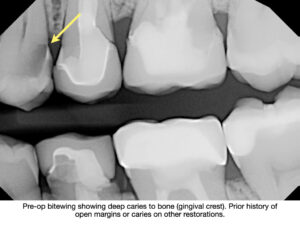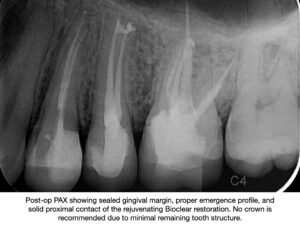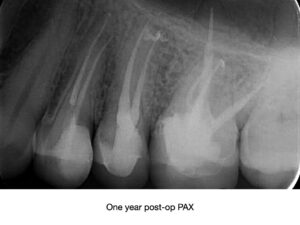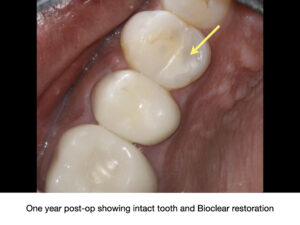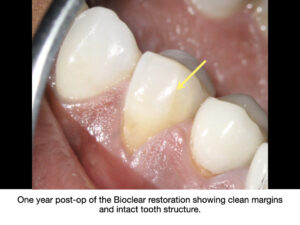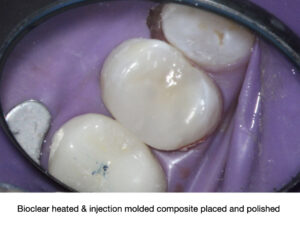Biomimetic and Bioclear Restorative
Elm Endodontics places a significant focus on the restorative component of endodontic treatment and vital pulp therapy. The reason for this is that a large majority of endodontic “failures” are really due to a weak link in the restorative component - recurrent decay, leaking fillings or crown margins, weak dentin or enamel bonds, or delays in getting final restorations.
Biomimetic dentistry puts a significant emphasis on selective decay removal and meticulous attention to the seal of filling material to dentin. Techniques for placing Bioclear restorations emphasize the bond of filling material to enamel and rejuvenate weak teeth by “shrink wrapping” the tooth in heated composite materials. The merging of these two schools of thought and the selective application of the best practices from each, while delivering treatment using a microscope and rubber dam isolation increases the options Dr. Shelley can propose to save difficult to restore teeth.
Here are a few principles that Dr. Shelley keeps in mind when proposing these treatment options to patients:
Vital Pulp Therapy and Selective Caries Removal
The best root canal is the one you never had to have! Sometimes patients are referred for root canal treatment because they have decay that is very near the pulp and the dentist is anticipating the need for endodontic treatment. In cases where there is deep decay, but mild to no symptoms, sometimes it is appropriate to consider an approach that tries to preserve the pulp. In order for this to work, it requires a discriminating approach to decay removal and preparation of the dentin and enamel to accept the filling material in a way that will seal and strengthen the tooth. This is more than a simple “pulp cap and filling”, and it takes more time than a typical filling, and sometimes takes longer than a root canal procedure, but is worth it if it means conserving tooth structure and maintaining pulp vitality.
Bioclear or Nothing
When a tooth has had a root canal and there is a large loss of tooth structure, a crown is often recommended. Unfortunately, in some cases, the process of placing the crown removes the last best remaining tooth structure and now the tooth is doomed to failure because of it. Extraction isn’t the only option. Applying Bioclear and biomimetic restorative principles can seal and rejuvenate the remaining tooth structure and give patients more options in saving their teeth.
This is a case where there wasn’t much good tooth structure left, and placing a crown would have left no natural tooth structure above the gumline. We were able to place a Bioclear restoration that preserved the remaining tooth structure and sealed the deep margin where the decay was.
This case was on my a member of my own family. In less than a year severe Extracanal Invasive Resorption (ECIR) overtook the tooth and endodontic treatment was required. But one of the problems was that the mesial wall was an enamel shell that if removed for a crown would now require a crown margin at the bone level, a very unfavorable restorative situation. One of the options was to place a Bioclear restoration to cover the tooth and close the gap between the teeth while preserving the enamel wall.
Deep Caries and Deep Margins
Often decay goes very deep below the gum. This is a difficult area to seal and restore because modern dental materials require a dry field and meticulous decay removal for an adequate bond and seal. In addition, at Elm Endodontics we use modern enhanced irrigation techniques for cleaning root canals like the Lightwalker Laser or the Gentlewave that demand a tight seal in order to benefit from their use.
Since the success of the root canal often relies on the technique of the restorative that follows, Dr. Shelley puts a significant emphasis on considering the restorative aspect and how the timing of that will relate to the endodontic treatment. Often the root canal is the “simple” part and the restorative is the more difficult part of the process for saving the tooth.
Saving teeth with deep caries often requires a specialized assortment of materials used under high magnification to get the job done at a high level of quality and predictability. At Elm Endodontics we keep these materials and techniques ready at our finger tips in order to offer the best possible outcome for saving your tooth.
Just for fun, here is a list of some of the materials we stock:
- Bioclear matrix bands and wedges
- A variety of separation rings
- Deep margin elevation bands
- Copper bands and strips
- Ribbond
- Hemostatics
- Erbium and Nd:YAG laser for gingivectomies and closed flap crown lengthening
- Laser curing lights for reaching deep dark places
- A variety of bonding agents
- Calcium trihydroxide blaster
- Aluminum Oxide micro etcher
- Teflon tape
- Gingival packing cord
- Large variety of rubber dam clamps for dry field isolation
- Light cure composite (heated), dual cure composite, glass ionomers, bioceramic glass
ionomer liners, high contrast flowable composites, amalgam, and more - Caries detector
- Polishing cups and paste
- Sound Seal for dry field isolation
- Sanding discs and strips
- Fiber and metal posts
At Elm Endodontics, we may propose an advanced restorative approach to saving your teeth. Keep in mind that we also provide treatments at the request of your general restorative dentist who may ask that we let them manage the restorative aspect. We respect their perspective and training and will do our best to balance honoring their requests while giving you quality care. We will make sure that your tooth is well sealed and ready for the next step in the process and that your dentist is informed of the process.
Contact us today to choose treatment under the care of Dr. Shelley at Elm Endodontics, which offers the best in modern care utilizing 3D CBCT imaging, treatment and diagnosis while using a microscope, enhanced irrigation technologies, and private rooms.


